It’s Time to License Interior Designers
In Massachusetts, the House and Senate are hearing a bill that would license the practice of Commercial Interior Design
 Sasaki
Sasaki
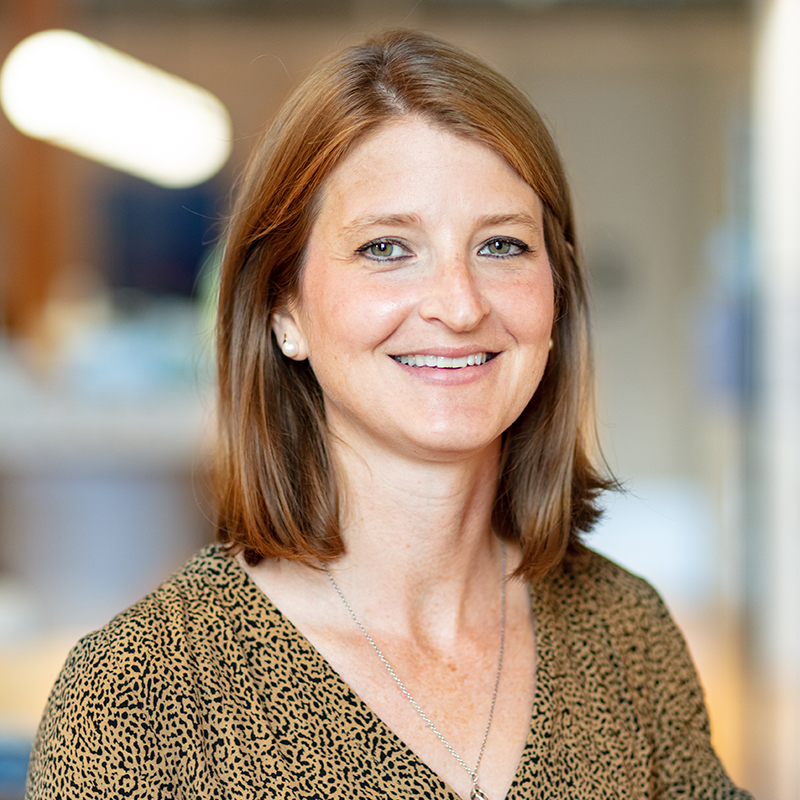
In March 2024, Sasaki interior designer Krista Easterly will be the featured guest of IIDA NE’s annual Business Leaders Breakfast. As the VP of Advocacy for IIDA New England, she has championed the cause of licensure on behalf of Massachusetts interior designers. She sat down with us last week to share her journey, the big questions in campus interior design, and what keeps her going.
Tell me about yourself. How’d you get here?
I went to the University of Vermont for my undergraduate where I majored in Political Science and Studio Art. My mother passed away the fall semester of my senior year and I really had no idea what I wanted to do. Reaching graduation was my only goal. I took a job that was not fulfilling and I was really unhappy. When I was young I had art lessons every weekend and completed my first oil painting at six years old. I tried to think of career paths that could harness my artistic skills but also be more pragmatic to balance my interests. I came across the Masters in Interior Design program at Suffolk, applied, and was accepted. The rest is history!
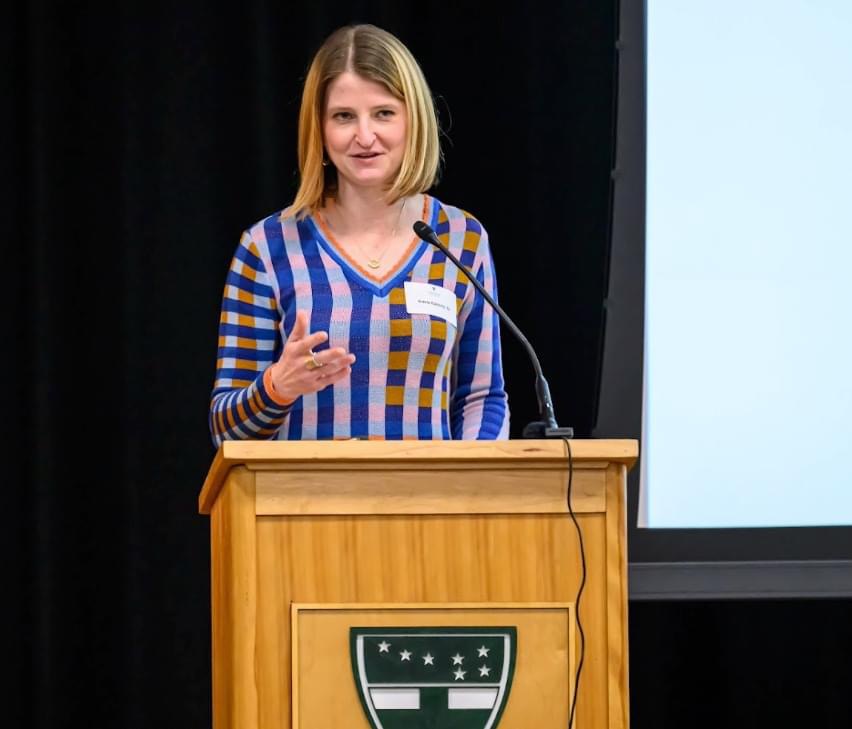
Krista delivers a keynote speech to students at her former high school for the Women in Leadership Forum in spring 2024
What do you enjoy about interior design?
First off, I love the interior design community in New England. It’s engaging, supportive, and vibrant. Projects come and go, but the community is really strong.
Over the past decade I have focused primarily on higher education projects. I feel that I have really found my home in this sector. In designing the student experience, I’m creating spaces where people learn, grow, get together, share experiences, find themselves—it feels like I’m doing good and impacting their growth and learning in a positive way.
Most recently I have really found the role of advocating for interior design incredibly rewarding. It’s an ongoing effort and one I am committed to.
How did you get involved with IIDA New England?
I have been lucky enough to work for firms which are very supportive about my professional development. I was first introduced to IIDA back in 2008 when I attended my first Fashion Show. Cristian Sirano was a guest judge and the whole event blew me away. I modeled in the 2009 Fabuless show and continued to model four more times when I was at Bergmeyer. I joined the Fashion Show Committee in 2016 and co-chaired the show in 2019.

Krista modeling at the IIDA NE Fashion show in 2014’s SENSEation while at Bergmeyer
The Fashion Show was kind of a gateway drug; it launched my deeper involvement in IIDA. In 2021 I was nominated to join the Board in the role of the VP of Advocacy. Since I studied political science at UVM and I knew the mission of Advocacy was to obtain licensure for Interior Designers, I jumped into it. I wanted to be able to engage with the design community in a more meaningful way and contribute something to the pressing issues in our industry, and it’s been awesome. I’m so glad I got involved.
Tell me about your push for licensure on behalf of Massachusetts interior designers.
Currently, interior designers are not not licensed professionals in the State of Massachusetts. We are not allowed to go after state or federal work. We can’t stamp and seal drawings, and we can’t sign contracts. We want to be treated as the professionals that we are because we are qualified by education, examination, and experience. This push is about interior designers trying to practice within the scope of work that we’ve been educated and trained to practice in.
That scope of work includes non-structural renovations and interior fit outs of commercial spaces; We know building codes, life safety, accessibility, etc. However, we’re not allowed to practice our scope without having an architect sign our drawings. It adds a financial burden to the consumer because we need to hire architects to stamp and seal drawings.
From a small business standpoint, the lack of licensure creates a lot of barriers. In order to go after state projects, Massachusetts requires design practices to be more than 50% owned by licensed professionals. Since interior designers can’t be licensed professionals, that also keeps them from being sole practitioners. They often sell part of their business to architects so they can pursue state work and risk losing their WBE designation.
Where are we in the process now?
As of this week, there are 29 states across the country that have interior design legislation. On March 5th, Nebraska passed their bill and Iowa passed last year. There is a great wave of momentum that we are hoping to catch in both Massachusetts and Rhode Island.
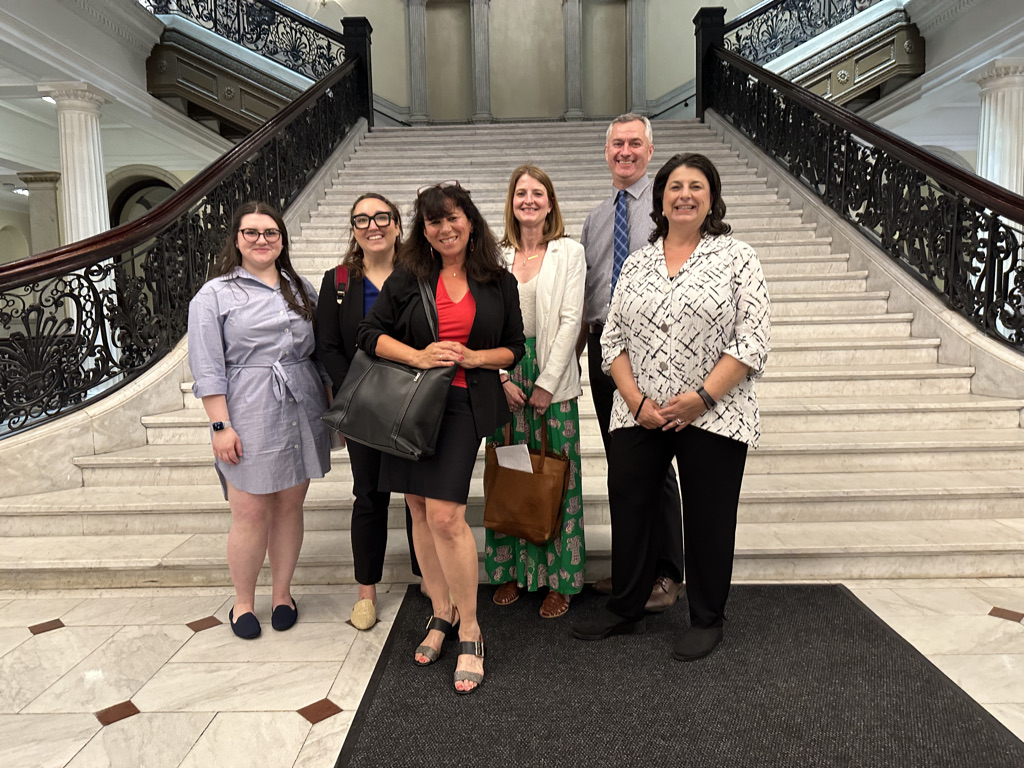
Krista and interior design colleagues after testifying at the Consumer Protection and Professional Licensure hearing at the Massachusetts State House in Spring 2023
This time last year, our bill was sitting in the Consumer Protection and Professional Licensure Committee and a group of us testified at a hearing. Within a week after the hearing we were favorably reported out of the committee and moved into the Senate Ways and Means. After the hearing I shared my testimony on LinkedIn and people really latched onto it. There has been a resurgence on the topic and conversation within the design community. I am thankful that we are picking up momentum but I am a product of those who led the way before me, Aimee Schefano and Corinne Barthelemy. Up until last year we had been having these conversations quietly, but opposition shifted and we were finally allowed to be LOUD! Aimee and Corrine paved the path for us to be in the place we are now.
What does interior design look like after the legislation passes?
I think it’s going to give consumers more options and allow designers to grow more in their respective firms by removing that glass ceiling. It’s going to allow professionals to start practicing in a different way. An interior designer could choose to start their own independent practice without having to hire an architect. If they don’t have to pay an architect to stamp their drawings, they won’t have to pass on the financial burden to consumers.
Within larger design firms, too, I think the interiors practice will become more robust. For a firm like Sasaki, the interiors practice is mostly focused on commercial interiors, but in the future I could see us building a really strong interiors group that focuses on renovation work of any type and scale. And since the current economy is favoring studies and renovations over new construction right now, harnessing that specialty would help us weather the ups and downs and raise our profile in the design community.
Was there a project that changed your perspective?
I started off doing retail banking design and other small scale projects of various typologies. In 2013 I was put on my first higher education project at UMass Lowell, and that really opened my eyes to a whole new project type. It was a dining hall renovation of a 1970s cast in place concrete building that somehow we turned into a dining hall, bakery, convenience store, classrooms, and student gathering spaces. I had never been exposed to a project of that scale and complexity before! It completely transformed that part of campus by creating a beacon of activity in an area that was previously without life. After that, I was hooked and I wanted to keep working in higher ed.
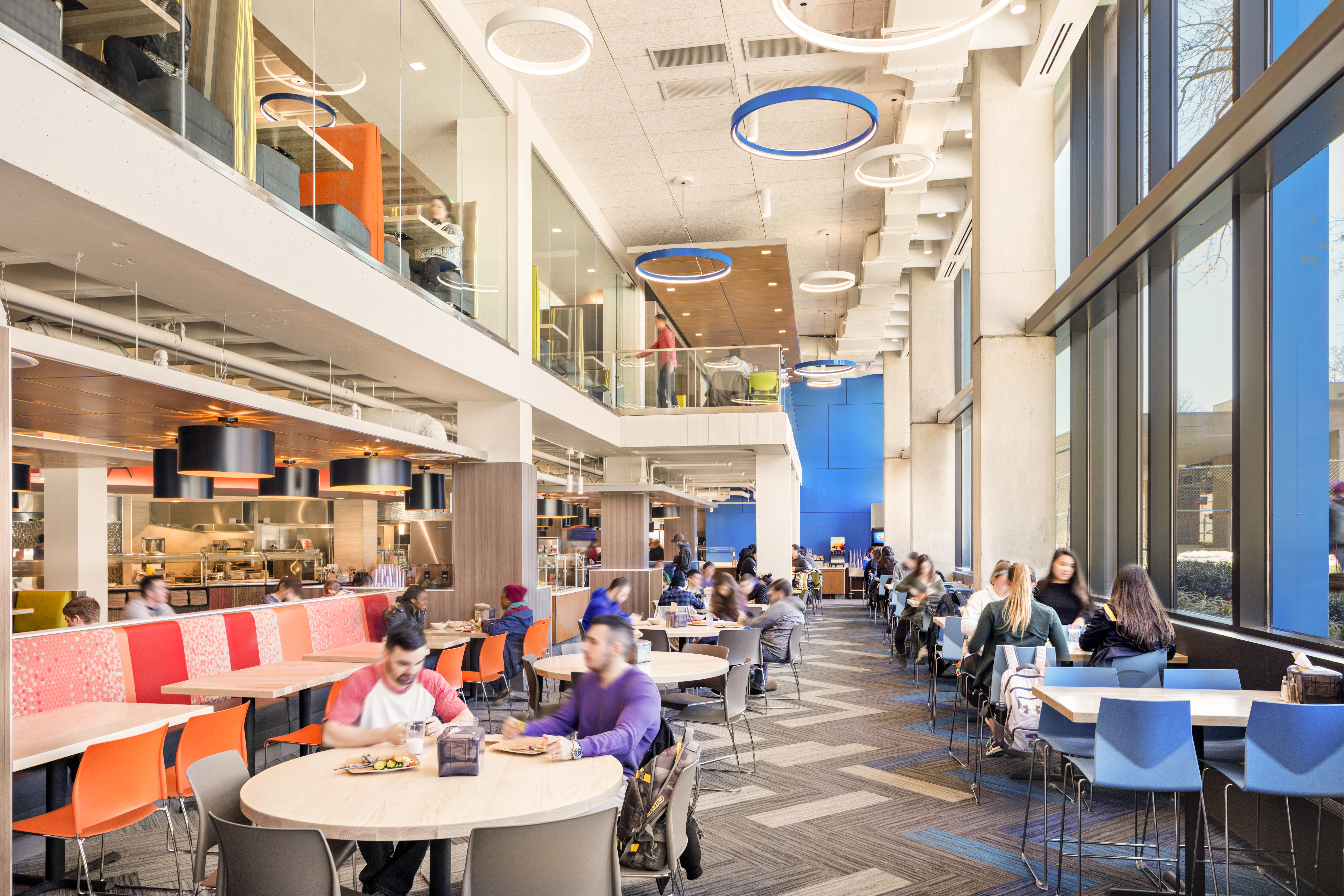
McGauvran Center at UMass Lowell. This was Krista’s first higher ed project while working at Bergmeyer (Image courtesy of Bergmeyer)
"In designing the student experience, I’m creating spaces where people learn, grow, get together, share experiences, find themselves—it feels like I’m doing good and impacting their growth and learning in a positive way."
What’s exciting you right now?
I am working on two projects down at Monterrey Tec in Monterrey, Mexico. One building, Expedition, is in construction, and we are in Design Development for the Innovation Hub. Both buildings are not only for students, but also for the innovation and research communities. We’re bringing together entrepreneurs, corporate entities, and researchers.
I wasn’t expecting to do international work, but I’m learning so much about the way the design process works in other parts of the world. At Monterrey Tec the team is collaborative and welcoming to our ideas and designs. They are very supportive partners. I am getting familiar with a new project type that will help support future research based projects, which is an exciting opportunity.
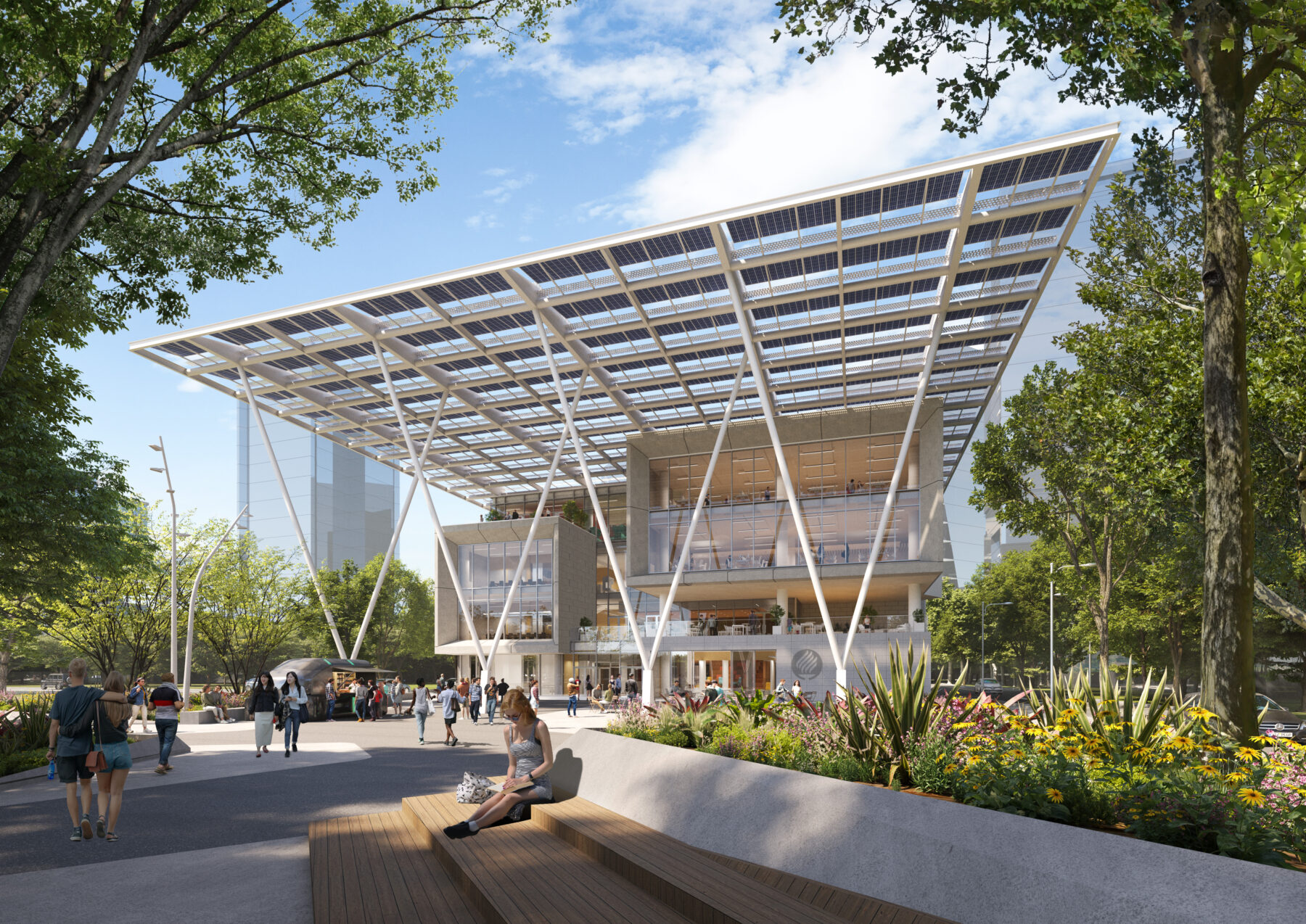
The Innovation Hub at Monterrey Tec will be the center of the newly developed Innovation District in Monterrey, Mexico. This building will bring together researchers, innovators, and entrepreneurs.
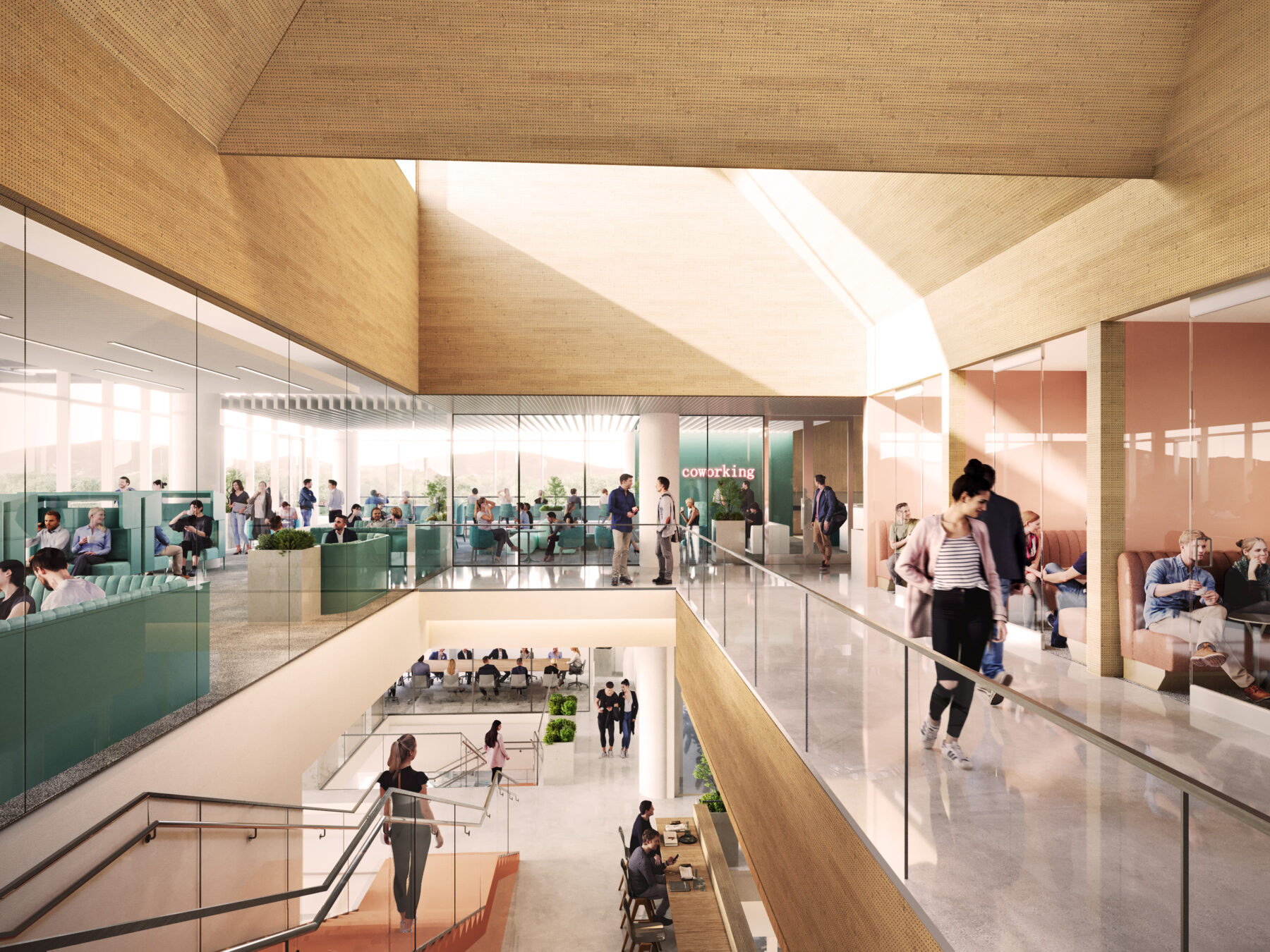
What will we be thinking about next in campus interiors?
Four rising themes that I see in campus interiors are wellness, access to technology, safety, and flexibility. In terms of wellness, schools are looking to give their students places for respite, places to be quiet, places to gather, where you can step away from what you’re doing—whether it’s a yoga room or a kitchen where you can make your own food in a student center. And campus design has to accommodate rapidly evolving technology trends and make it easy to incorporate that into learning spaces—you always have to be able to plug into power and Zoom, for instance.
Our clients are also trying to the right level of comfort and security so their students feel safe on campus in the places they sleep, work, and learn. Finally, we design spaces for ultimate flexibility for future use (for example, if you need to be able to switch out equipment in a few years) and also to allow students a variety of ways of working. It allows the universities to pivot to new trends and enforce proper learning models and technology changes.
Is there anything you want to do more of?
I would like to do more renovations of student spaces within campus communities. I like the process of taking a building that’s not loved enough, or it’s been through it, and bringing it back to life by creating spaces where students and faculty come together. They are really challenging projects because you’re trying to fit all these pieces into an existing space and rehabilitate it. It’s an intricate puzzle that needs solving.
I also want to design more dining halls—I like the combination of food and the social student experience. I’m a social person and I like bringing people together, and food is a powerful vehicle to make that happen.
I would really like to design for people with special needs and disabilities. I have a sister with Down’s syndrome who lives in a group home, so I see a lot of the special needs community and I know there is a need to create more spaces to suit their needs. Being able to design spaces for them would be incredibly interesting and rewarding, and I think giving them the gift of a well-designed space would be so appreciated.
My long term goal is to open a coffee shop that employs all individuals with special needs. This will give them an amazing opportunity to work within the community and find a greater quality of life. There are models and franchises out there that exist. I just need to find some investors. If anyone out there is interested, please let me know!